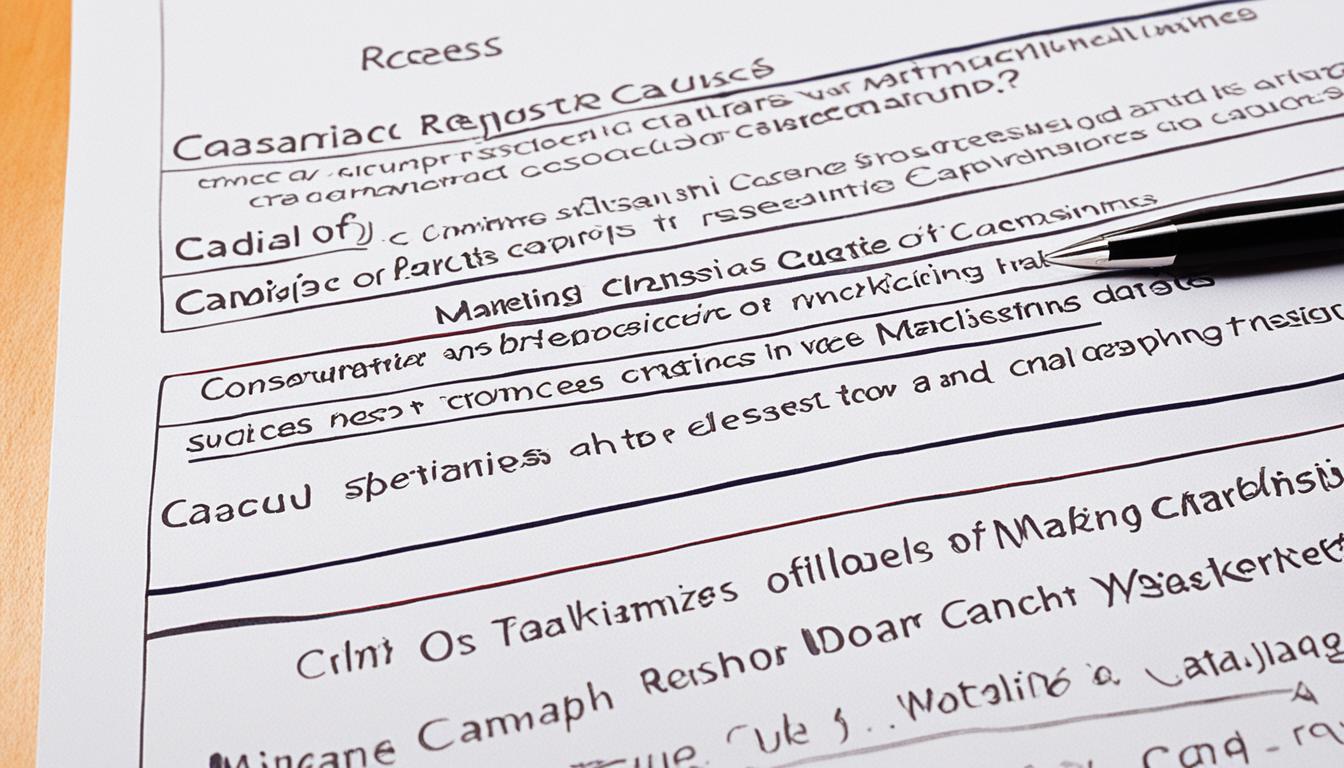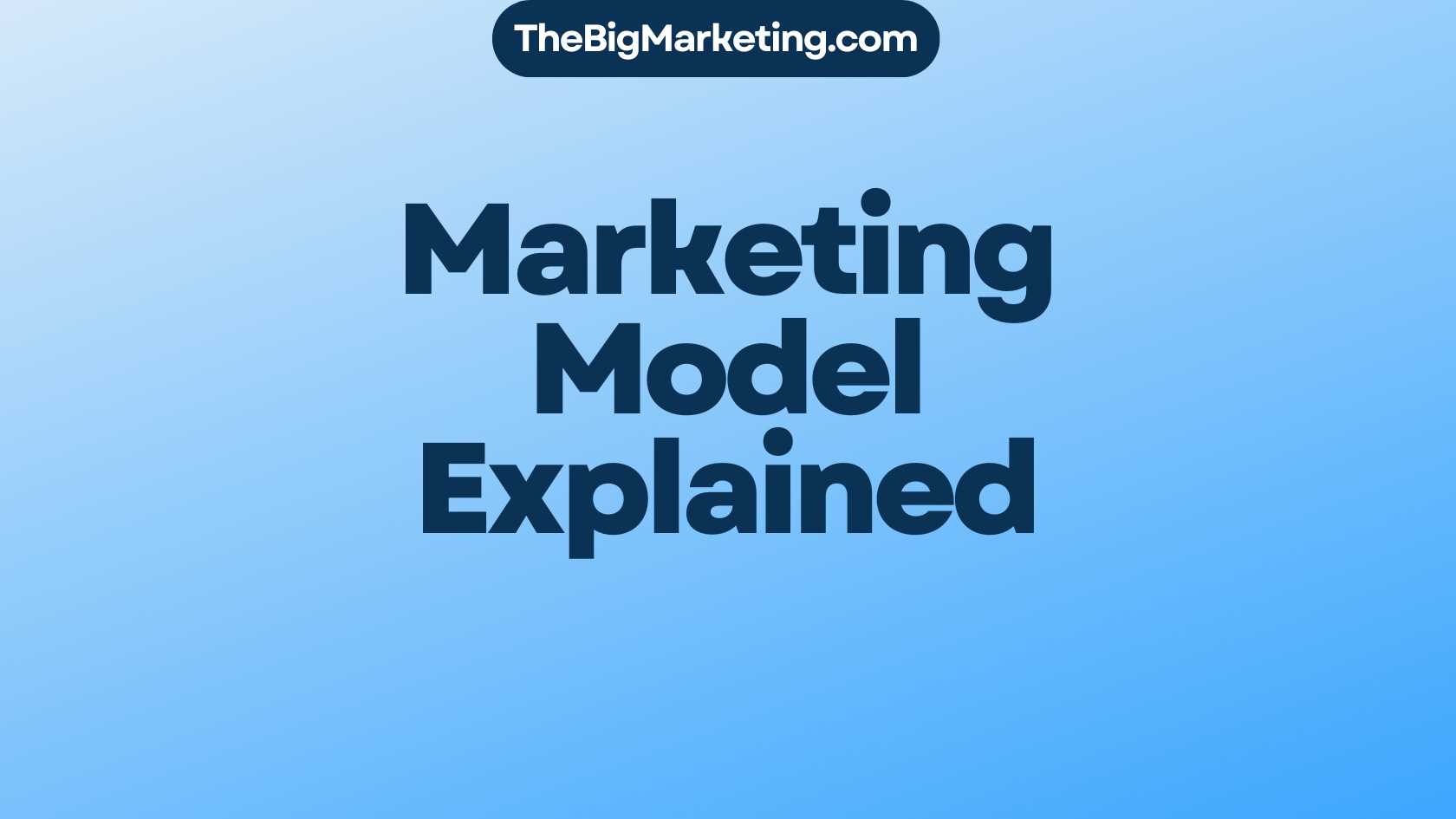Multi-touch attribution (MTA) helps in understanding how each part of the marketing process affects a customer’s decision to buy. It breaks down the journey and gives value to each marketing channel involved. There are a few models like first-touch, last-touch, linear, U-shaped, and data-driven.
Key Takeaways:
- Multi-touch attribution (MTA) is a marketing measurement method that assigns credit to each touchpoint on the customer journey.
- MTA helps marketers understand the impact of each touchpoint on driving conversions and optimizing ad spend.
- There are several multi-touch attribution models, including first-touch, last-touch, linear, U-shaped, and data-driven models.
- Multi-touch attribution provides a granular view of the customer journey and helps marketers improve marketing ROI.
- Choosing the right multi-touch attribution model is crucial for accurate measurement of marketing performance.
What is Multi-Touch Attribution?
Multi-touch attribution is a way to see how each part of advertising affects customer decisions. It looks at the customer’s journey across different devices. It shows which ads they see. This method helps marketers understand which ads really lead to sales. They can see which parts of their advertising work best.
It’s important for marketers to know how customers decide to buy something. Multi-touch attribution gives a full picture of the customer’s experience. It looks at every step from when they first hear about a product to when they buy it. This helps make sure that each advertising channel gets the right amount of credit for its part in a sale.
The Difference Between Multi-Touch Attribution vs. First-Touch vs. Last Touch Models
There are several ways to view attribution models, including multi-touch, first-touch, and last-touch. Each method has its pros and cons in evaluating how marketing efforts affect sales.
First-Touch Attribution:
The first-touch model gives all the credit to the very first marketing interaction a customer has. This approach only looks at the first step and ignores others in the journey. It’s good for seeing what gets customer interest but misses the full story.
Last-Touch Attribution:
Last-touch model, on the other hand, credits the final step before a customer buys. It hones in on the conversion-triggering touchpoint. However, like first-touch, it overlooks the path that led there.
Multi-Touch Attribution:
Multi-touch attribution looks at every step and distributes credit among them. It shows how all interactions lead to a sale, giving a complete picture. This method values every marketing effort and guides in optimizing strategies.
Let’s look at the main differences between these methods:
| Model | Focus | Strengths | Limitations |
|---|---|---|---|
| First-Touch Attribution | Initial touchpoint | – Identifies the touchpoint that captures customer interest – Provides insights into lead generation |
– Ignores the impact of subsequent touchpoints – Does not consider the overall customer journey |
| Last-Touch Attribution | Final touchpoint | – Identifies the touchpoint that directly leads to conversion – Highlights the touchpoint with the highest impact |
– Neglects the influence of earlier touchpoints – Misses the bigger picture of the customer journey |
| Multi-Touch Attribution | All touchpoints | – Provides a holistic view of the customer journey – Recognizes the contribution of each touchpoint – Helps optimize marketing strategies based on data-driven insights |
– Requires advanced analytics tools for accurate measurement – Can be complex to implement without proper resources |
Knowing the differences helps marketers choose the best model for their goals. Multi-touch gives a deep dive into how all steps influence a sale. This allows for better marketing optimization and improved outcomes.
Benefits of Multi-Touch Attribution
Multi-touch attribution models give marketers deep insights. They show the customer’s path and how different marketing actions work across channels. This knowledge helps marketers tweak their messages, improve the shopping experience, and boost their marketing success.
One big plus of multi-touch attribution is seeing every step of the customer’s path. Marketers can see how each interaction, from the first moment of interest to buying, impacts the journey. They learn which steps are most important.
This insight lets marketers make their strategies better and spend their budget smarter. By knowing which channels and steps matter most, marketers can put more effort and money there. This leads to better marketing results.
Also, multi-touch attribution helps marketers make their sales process faster by using stronger, more focused messages. Knowing which interactions matter most lets marketers create content that is more likely to lead to sales.
Overall, multi-touch attribution is a key tool for marketing analysis. It offers deep looks into how customers shop, helps marketers spend smarter, and gets better results. It changes how marketers plan and improve their campaigns for better customer experiences.
Benefits of Multi-Touch Attribution
| Benefits | Description |
|---|---|
| Granular View | Provides a detailed understanding of the customer journey and touchpoints across different channels. |
| Optimize Marketing ROI | Identifies the most effective channels and touchpoints, allowing marketers to allocate spend more efficiently. |
| Shorten Sales Cycles | Enables marketers to deliver more impactful and targeted marketing messages, resulting in quicker conversions. |
Types of Multi-Touch Attribution Models
There are several multi-touch attribution models for marketers. Each model has its way of giving credit to customer interactions. Here are the most popular ones:
1. Linear Attribution
The linear model shares credit equally among all touchpoints. It treats each customer interaction the same, regardless of when it happens. This view is fair but might not show the true value of key touchpoints.
2. U-Shaped Attribution
U-shaped attribution focuses on the first and last touchpoints. It values the start and end of the customer journey the most. The other touchpoints get credit but not as much.
3. Time Decay Attribution
With time decay attribution, closer touchpoints to conversion get more credit. It suggests that interactions near the conversion influence the decision more. This model fits well for sales that happen over time.
4. Data-Driven Attribution
The data-driven model uses machine learning to analyze customer paths. It identifies which touchpoints really matter. By looking into data, it gives the most accurate credit to interactions.
| Attribution Model | Key Characteristics |
|---|---|
| Linear Attribution | Equal credit to all touchpoints |
| U-Shaped Attribution | More credit to first and last touchpoints |
| Time Decay Attribution | More credit to touchpoints closer to conversion |
| Data-Driven Attribution | Utilizes machine learning and advanced analytics |
Different multi-touch attribution models have their pros and cons. The right one depends on your campaign’s needs and goals. Using the best model will help you understand and improve your marketing’s impact. It leads to better conversions and a higher return on investment.
Linear Multi-Touch Attribution Model
The linear multi-touch attribution model is popular in marketing. It gives equal credit to each touchpoint in the buyer’s journey. This ensures all touchpoints are considered in the analysis.
But, it overlooks the individual impact of each touchpoint on the final decision. The linear model paints a broad picture of the customer journey. Yet, it might not accurately value touchpoints with major impacts on conversion.
Benefits of the Linear Multi-Touch Attribution Model
- Uniform credit distribution: The linear model ensures every touchpoint gets equal credit. This gives a fair view of all marketing channels involved in the conversion.
- Comprehensive analysis: Including all touchpoints provides a complete look at the customer journey. It helps uncover touchpoints that might be missed in other models.
- Ad effectiveness insights: This model evaluates how individual ads perform across touchpoints. It offers insights into the effectiveness of various marketing efforts.
This model offers a balanced view of credit for touchpoints. But, marketers should be aware of its limits and the possible undervaluation of key touchpoints. For a deeper insight into touchpoint effectiveness, exploring other multi-touch models is beneficial. These models consider the unique aspects of their customer journey.
U-Shaped Multi-Touch Attribution Model
The U-shaped multi-touch attribution model values the first and last touchpoints in marketing. It gives most credit to these touchpoints, less to others in between. This approach helps to understand what starts and ends the buyer’s journey.
By focusing on the first touchpoint, we learn what sparks interest in customers. Giving importance to the last touchpoint reveals what seals the deal. This method shows us the importance of initial and closing interactions with customers.
This model sees customer behavior as shaped by many touchpoints. It highlights the most crucial moments in decision-making. While middle touchpoints support, the model centers on those with the most impact on decisions and sales.
Advantages of the U-Shaped Multi-Touch Attribution Model
- Highlights the importance of the first and last touchpoints
- Provides insights into touchpoints that initiate the customer journey and drive conversions
- Enables marketers to allocate resources effectively by focusing on key touchpoints
- Allows for a better understanding of the overall customer journey and the effectiveness of different marketing channels
This model offers valuable insights but may overlook some touchpoint’s influence. Marketers should consider using multiple models or data-driven attribution for a fuller picture.
| Model | Description |
|---|---|
| First-Touch Attribution | Assigns full credit to the first touchpoint |
| Last-Touch Attribution | Assigns full credit to the last touchpoint |
| U-Shaped Multi-Touch Attribution | Assigns more credit to the first and last touchpoints |
| Linear Attribution | Assigns equal credit to all touchpoints |
| Data-Driven Attribution | Utilizes machine learning to analyze customer journeys and assign credit based on impact |
Time Decay Multi-Touch Attribution Model
The time decay multi-touch attribution model focuses on the latest touchpoints before conversion. It believes the final interactions are crucial for leading to a conversion. Thus, it values recent interactions more than the initial ones.
Conversion Impact
This model gives more importance to the last touchpoints. It sees their big role in making the customer decide to buy. These touchpoints have a big influence on the final buying decision.
Bottom of the Funnel
Bottom-of-the-funnel touchpoints happen in the last stages before buying. They are key because they involve things like product demos or adding to the cart. The time decay model gives these touchpoints a lot of credit for being close to the sale.
The table below shows how the time decay model divides credit:
| Touchpoint | Credit Allocation |
|---|---|
| First touchpoint | 5% |
| Second touchpoint | 15% |
| Third touchpoint | 30% |
| Fourth touchpoint | 50% |
The table tells us that the model gives less credit as touchpoints get further from the sale. The first interaction gets only 5% credit. The fourth one, being closest to the sale, gets a big 50% of the credit.
Data-Driven or Machine Learning Multi-Touch Attribution Model
The most advanced way to understand marketing is through the data-driven or machine learning multi-touch attribution model. This model uses machine learning to look closely at customer actions. It finds out which channels and moments really help convince customers.
This model takes historical data and advanced tools to give a clearer view of how marketing is doing. It considers complex interactions in the customer’s journey that simple rules might miss.
Machine learning can spot connections between touchpoints and sales that aren’t obvious otherwise. This lets marketers understand what works best. It helps them use data to improve their strategies.
Benefits of the Data-Driven Multi-Touch Attribution Model:
- It measures marketing success across all channels and moments.
- Finds key moments that greatly affect sales.
- Helps spend the marketing budget on what works best.
- Gives a deeper look into what customers like and do.
- Lets marketers change tactics quickly as customer interests shift.
To use a data-driven multi-touch attribution model, you need good data, the right tools, and machine learning know-how. Companies that do this well can better understand their customers. They can make their marketing more effective, increasing both impact and ROI.
Comparison of Attribution Models
| Attribution Model | Main Characteristics | Limitations |
|---|---|---|
| Data-Driven Multi-Touch Attribution | Uses machine learning to study customer paths and find important moments. | Needs historical data and the right analytical tools. |
| Last-Touch Attribution | Gives all the credit to the final step before a sale. | Ignores the role of earlier steps. |
| First-Touch Attribution | Allocates all the credit to the journey’s start. | Fails to see the value of later steps. |
| Linear Attribution | Gives equal value to all steps toward purchase. | Misses how some moments matter more than others. |
| Time Decay Attribution | Values steps closer to purchase more highly. | Can neglect earlier steps that lay groundwork for a sale. |
What is Multi-Touch Attribution?
Multi-touch attribution lets marketers track their ad efforts well. It matches ad views with customer data. This shows which ads lead to sales. It’s key for understanding how customers decide to buy.
This method mainly looks at online ads. While print and TV ads are important, they’re hard to track this way. So, multi-touch attribution works best with digital ads.
However, it needs user data to work. When we know who the customer is, it gives great insights. But without known customer data, it’s harder to see results.
Addressable Media and Customer Identity Data
Addressable media lets marketers target certain people online. They use your online actions and interests for this. Platforms like social media and search engines are examples.
This method helps send personalized messages that hit the mark. With multi-touch attribution, marketers can see how well these channels work. Then, they can use their ad budget smarter.
Yet, this method leans on having good customer data. This includes email or device IDs that show someone’s ad views and if they bought something.
Limitations and Considerations
Multi-touch attribution is great but has limits. One issue is that it’s geared towards online ads. This makes tracking print or TV ads difficult.
Also, it really depends on having detailed customer data. If we don’t know who the customer is or have partial data, it’s tougher to see what’s working.
Despite its challenges, this method is still valuable. It helps marketers understand the effect of their ads. They can then spend their budget more wisely and learn about their customers’ habits.
Different Types of Multi-Touch Attribution
Marketers can choose from several multi-touch attribution models. Each model has its own way of crediting marketing touchpoints in the customer journey. Let’s look at the most common ones:
Last-Touch Attribution
Last-touch attribution gives all credit to the final ad clicked. This model views the last touchpoint as key in conversion. Thus, marketers using it focus on optimizing the journey’s end.
First-Touch Attribution
First-touch attribution gives all credit to the first ad a customer clicks. It holds the first touchpoint as the conversion’s main driver. Marketers believe the first interaction is crucial for a successful conversion.
Fractional Attribution
Fractional attribution divides credit among several touchpoints. It uses rules or weights to value different points in the funnel. This method recognizes every touchpoint’s role in conversion.
Algorithmic Attribution
Algorithmic attribution uses data analysis and machine learning to assign credit. It looks at data, behavior, and touchpoint impact to credit accurately. This method offers a data-driven credit assignment.
Each attribution model has its pros and cons. The choice depends on what the marketer aims for and the resources they have. Now, let’s compare these models in detail:
| Attribution Scheme | Key Features | Advantages | Limitations |
|---|---|---|---|
| Last-Touch Attribution | Fully credits the last touchpoint before conversion | Easy to implement and understand | Overlooks the contribution of other touchpoints |
| First-Touch Attribution | Fully credits the first touchpoint in the customer journey | Highlights the initial touchpoint’s impact | Discounts the influence of subsequent touchpoints |
| Fractional Attribution | Assigns weighted values to multiple touchpoints | Offers a more comprehensive view of the customer journey | Requires predetermined rules or weights |
| Algorithmic Attribution | Utilizes machine learning and analytics to calculate credit | Accurately captures complex customer behaviors | Relies on access to historical data and advanced analytics tools |
Understanding these multi-touch attribution models helps marketers make better decisions. They can analyze their marketing impact and fine-tune their strategies effectively.
Conclusion
Multi-Touch Attribution (MTA) is a key tool for marketers. It helps them see how effective different touchpoints are in the customer journey. With MTA, they can better use their ad budgets, get valuable marketing insights, and see how each touchpoint leads to sales. This lets them make smart decisions and give customers what they want.
Choosing the right MTA model is vital for marketers. There are several types, like linear, U-shaped, and time decay models. Each one has its own benefits. Marketers need to think about their goals, how their customers act, and what data they have. This helps pick the best model for their needs.
At the end of the day, Multi-Touch Attribution helps marketers plan better. It’s all about knowing the customer journey, tracking sales, and analyzing data. This can lead to better marketing results, happier customers, and a stronger return on investment.



